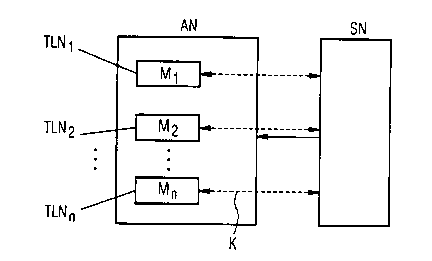Some of the information on this Web page has been provided by external sources. The Government of Canada is not responsible for the accuracy, reliability or currency of the information supplied by external sources. Users wishing to rely upon this information should consult directly with the source of the information. Content provided by external sources is not subject to official languages, privacy and accessibility requirements.
Any discrepancies in the text and image of the Claims and Abstract are due to differing posting times. Text of the Claims and Abstract are posted:
| (12) Patent Application: | (11) CA 2336274 |
|---|---|
| (54) English Title: | METHOD FOR OPTIMIZING THE AVAILABLE TRANSMISSION CAPACITY AT SUBSCRIBER LINE NETWORKS |
| (54) French Title: | PROCEDE D'OPTIMISATION DE LA CAPACITE DE TRANSMISSION DISPONIBLE DE RESEAUX D'ACCES D'ABONNES |
| Status: | Deemed Abandoned and Beyond the Period of Reinstatement - Pending Response to Notice of Disregarded Communication |
| (51) International Patent Classification (IPC): |
|
|---|---|
| (72) Inventors : |
|
| (73) Owners : |
|
| (71) Applicants : |
|
| (74) Agent: | SMART & BIGGAR LP |
| (74) Associate agent: | |
| (45) Issued: | |
| (86) PCT Filing Date: | 1999-02-08 |
| (87) Open to Public Inspection: | 2000-01-06 |
| Examination requested: | 2000-12-28 |
| Availability of licence: | N/A |
| Dedicated to the Public: | N/A |
| (25) Language of filing: | English |
| Patent Cooperation Treaty (PCT): | Yes |
|---|---|
| (86) PCT Filing Number: | PCT/EP1999/000815 |
| (87) International Publication Number: | WO 2000001104 |
| (85) National Entry: | 2000-12-28 |
| (30) Application Priority Data: | ||||||
|---|---|---|---|---|---|---|
|
In customer access networks wherein information is exchanged according to a
transmission method xDSL, a problem arises in that the maximum available
transmission capacity is highly dependent on physical conditions of
compatibility. If these conditions are modified, the modems must adapt
themselves again. If the initial transmission capacity is not reached any
longer, the xDSL line is taken out of service. The present invention solves
this problem by establishing a communication channel between the modem and a
central control logic.
Dans des réseaux d'accès d'abonnés par l'intermédiaire desquels les informations sont échangées selon un procédé de transmission xDSL, le problème est posé par le fait que la capacité de transmission maximale possible dépend très fortement des conditions cadres physiques. Si ces dernières sont modifiées, les modems doivent à nouveau s'adapter. Si la capacité de transmission initiale n'est plus atteinte, la ligne xDSL est mise hors service. La présente invention permet de résoudre ce problème grâce à l'établissement d'un canal de communication entre le modem et une logique de commande centrale.
Note: Claims are shown in the official language in which they were submitted.
Note: Descriptions are shown in the official language in which they were submitted.

2024-08-01:As part of the Next Generation Patents (NGP) transition, the Canadian Patents Database (CPD) now contains a more detailed Event History, which replicates the Event Log of our new back-office solution.
Please note that "Inactive:" events refers to events no longer in use in our new back-office solution.
For a clearer understanding of the status of the application/patent presented on this page, the site Disclaimer , as well as the definitions for Patent , Event History , Maintenance Fee and Payment History should be consulted.
| Description | Date |
|---|---|
| Time Limit for Reversal Expired | 2007-02-08 |
| Application Not Reinstated by Deadline | 2007-02-08 |
| Inactive: Abandoned - No reply to s.30(2) Rules requisition | 2006-05-29 |
| Inactive: Abandoned - No reply to s.29 Rules requisition | 2006-05-29 |
| Deemed Abandoned - Failure to Respond to Maintenance Fee Notice | 2006-02-08 |
| Inactive: S.30(2) Rules - Examiner requisition | 2005-11-29 |
| Inactive: S.29 Rules - Examiner requisition | 2005-11-29 |
| Inactive: Cover page published | 2001-04-09 |
| Inactive: First IPC assigned | 2001-03-29 |
| Letter Sent | 2001-03-19 |
| Inactive: Acknowledgment of national entry - RFE | 2001-03-19 |
| Application Received - PCT | 2001-03-17 |
| Request for Examination Requirements Determined Compliant | 2000-12-28 |
| All Requirements for Examination Determined Compliant | 2000-12-28 |
| Application Published (Open to Public Inspection) | 2000-01-06 |
| Abandonment Date | Reason | Reinstatement Date |
|---|---|---|
| 2006-02-08 |
The last payment was received on 2005-01-14
Note : If the full payment has not been received on or before the date indicated, a further fee may be required which may be one of the following
Please refer to the CIPO Patent Fees web page to see all current fee amounts.
| Fee Type | Anniversary Year | Due Date | Paid Date |
|---|---|---|---|
| Registration of a document | 2000-12-28 | ||
| Basic national fee - standard | 2000-12-28 | ||
| Request for examination - standard | 2000-12-28 | ||
| MF (application, 2nd anniv.) - standard | 02 | 2001-02-08 | 2000-12-28 |
| MF (application, 3rd anniv.) - standard | 03 | 2002-02-08 | 2002-01-21 |
| MF (application, 4th anniv.) - standard | 04 | 2003-02-10 | 2003-01-24 |
| MF (application, 5th anniv.) - standard | 05 | 2004-02-09 | 2004-01-16 |
| MF (application, 6th anniv.) - standard | 06 | 2005-02-08 | 2005-01-14 |
Note: Records showing the ownership history in alphabetical order.
| Current Owners on Record |
|---|
| SIEMENS AKTIENGESELLSCHAFT |
| Past Owners on Record |
|---|
| STEFAN SCHRODER |